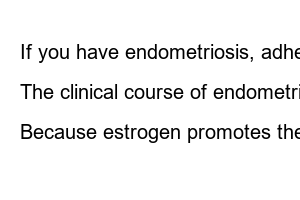자궁내막증 증상Endometriosis is a disease that progresses continuously, so it is most important to detect it early and treat it appropriately.
The exact cause of endometriosis is not yet known, but there are roughly two theories. One is that the endometrial tissue shed along with menstrual blood during menstruation flows backwards into the abdominal cavity through the fallopian tubes and is transplanted into the peritoneum, etc. Another possibility is that normal peritoneal epithelium changes into endometrium.
Up to 40% of infertile women are reported to have endometriosis, and it is also common among women who complain of chronic pelvic pain.
Endometriosis is most commonly found among women ages 30 to 44, but it can also occur in those in their teens and twenties. In particular, women who have suffered from endometriosis in the family, women who secrete excessive female hormones, women who have a menstrual cycle of less than 27 days or more than 7 days, women who are obese or drink alcohol are at risk for endometriosis. It is known that the frequency of occurrence is high. Conversely, the frequency is known to be reduced in women taking oral contraceptives and women using intrauterine contraceptive devices (Loop).
Symptoms due to endometriosis vary depending on the location of the lesion, the affected organ, and the extent of the lesion. Typical symptoms are pain and infertility, and if you have any of the following symptoms, you must seek consultation about endometriosis at a hospital.
– When an orthopedic abnormality cannot be detected or symptoms do not improve even after receiving orthopedic or physical therapy
If you have endometriosis, adhesions (sticking of skin or membranes that should be apart) occur around the ovaries and fallopian tubes, preventing ovulation and egg movement. Additionally, various substances secreted from endometriosis tissue can have a negative effect on eggs, sperm, and embryos, causing problems with the development and implantation of embryos and causing infertility.
A definite diagnosis can only be made through visual inspection through laparoscopy or open surgery, as well as histological examination. However, in order to receive these diagnostic procedures and treatments, women must first be familiar with endometriosis. Also, when symptoms appear, it is most important to suspect endometriosis and go to the hospital to undergo a medical examination, serological test, and ultrasound.
The clinical course of endometriosis as well as treatment methods vary depending on the severity of the disease. Endometriosis is treated by examining the size and depth of the lesion and the degree of adhesion, and dividing it into stages from mild stage 1 to severe stage 4.
Painkillers and anti-inflammatory medications can be effective in relieving menstrual pain and pelvic pain.
Because estrogen promotes the growth of endometrial tissue, drugs that inhibit the action of estrogen are sometimes used.

